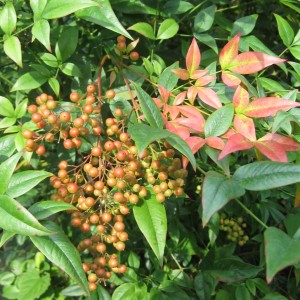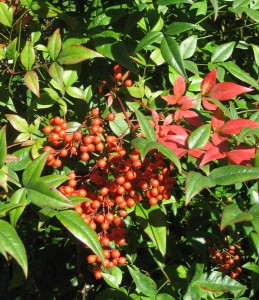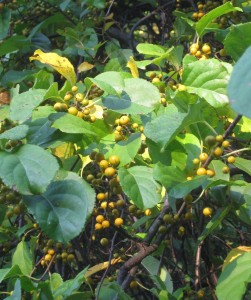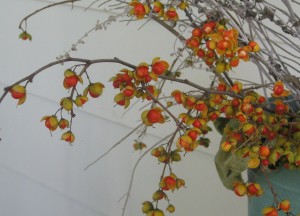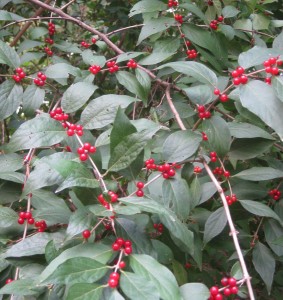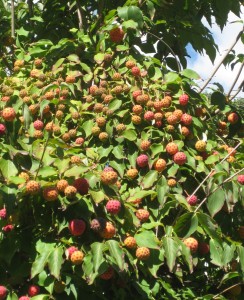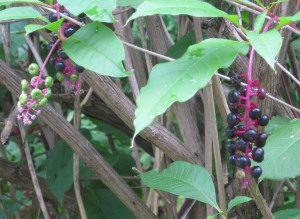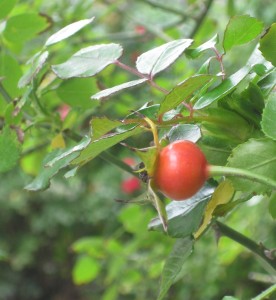The neat, grape-like clusters of nandina were our stand-in for holly. And when we transformed the concrete wasteland behind our Virginia house into a real backyard with actual plants, I knew I wanted to include nandina, or heavenly bamboo, which spoke so clearly of home. The green, lacy foliage turns red in the fall, just like its fruit. The nandina berries, I can happily say, are ripening now along our fencerow. If the birds don’t eat them all, I’ll have some to bring in for Christmas.
About a week after the above photo, the nandina berries and foliage are brighter still.
I find bittersweet to be a particularly enchanting vine. It didn’t grow in Atlanta, but I vaguely remembered it from my younger days in Kentucky. I rediscovered it in the woodsy surroundings of our first apartment in New Jersey. I brought it in by the armful. Like wild trumpet vine, it’s one of those climbing plants that can take over if left unchecked. Here in Virginia, we typically see bittersweet growing in a pleasant tangle at the edge of the woods. Its berries pass through several different stages, all interesting and attractive. In early summer, the new berries are bright green, surrounded by abundant leaves. Gradually the berries turn yellow, as above. With cooler weather, the hulls pop open to reveal bright orange-red seed globes, segmented rather like tiny beach balls. The pliable, free-form vines are easily wound into wreaths.
Once cut, the bittersweet pods quickly open to reveal their red-orange fruit.
The bright cherry-red berries of fall honeysuckle shine with a silvery glow like bubble-shaped jewels. Each berry is perfect–perfectly red, perfectly round, perfectly sized. I learned the hard way not to bring these inside–they are very juicy and tend to stain tablecloths and rugs.
This Japanese dogwood or Kousa Tree is laden now with its characteristically lumpy, globular fruit, which are edible and said to be tasty, although I’ve never sampled them. For some reason, they strike me as vaguely futuristic, like something we might see on the Jetsons.
During the years before we renovated our backyard, one of our few touches of greenery was an immense pokeweed that sprung up every spring in a small patch of ground beside our old porch. It offered some shade and color, and the birds flocked to its berry clusters. I enjoy the plant’s evolving appearance. At the ends of young stems, tiny, pale pink blossoms appear in early spring. These are transformed first into bright green berries and, in late summer, into plump, dark-purple spheres. The stems also change color, from a lavender pink to a bold magenta. The vigorous heartiness of pokeweed, as well as its amazing rate of growth, make it a force to be respected. Long used in herbal remedies, the plant is being studied as a possible cancer-fighter due to its established antiviral properties. Children should nevertheless be warned that the luscious-looking berries can be toxic to humans.
In late summer and fall, the pink climbing roses on our garage trellis give way to these jumbo rose hips that resemble large gumballs or miniature tomatoes. A Martha Stewart disciple would laboriously harvest them for jam, but we are content to appreciate their autumn color. Kiko occasionally awakens from sleeping in the sun to munch on a rose hip if one happens to have fallen nearby. He seems to find them tastiest when they are rather shriveled and overly ripe.

